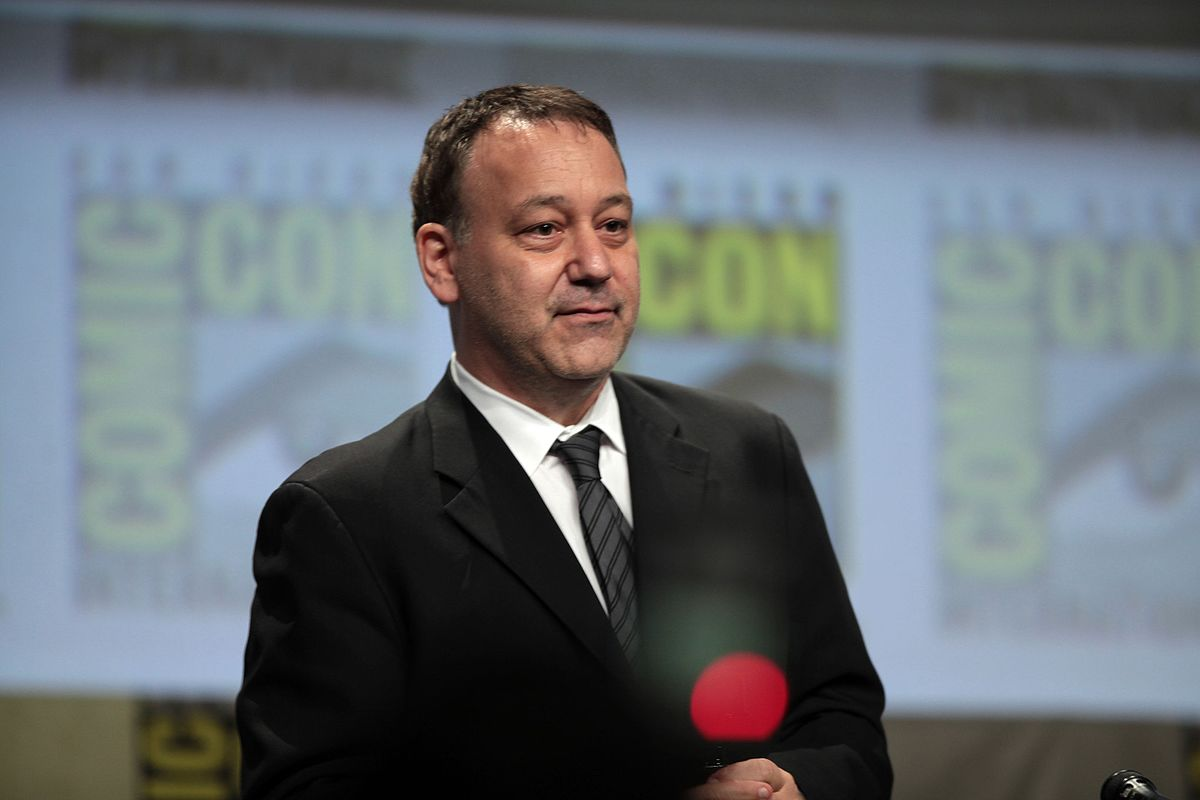Title of the work
Studio / Production Company
Country of the First Edition
Country/countries of popularity
Original Language
First Edition Date
First Edition Details
Hercules in the Maze of the Minotaur. Directed by Josh Becker; written by Andrew Dettmann, and Daniel Truly. USA, (Universal) Action Pack Weds 8-10pm (syndicated television); 14 November 1994. 90 mins.
Running time
Format
Date of the First DVD or VHS
Genre
Action and adventure fiction
B films
Mythological fiction
Television series
Target Audience
Crossover
Cover

We are still trying to obtain permission for posting the original cover.
Author of the Entry:
Joel Gordon, University of Otago, joel_gordon@hotmail.co.nz
Peer-reviewer of the Entry:
Elizabeth Hale, University of New England, ehale@une.edu.au
Elzbieta Olechowska, University of Warsaw, elzbieta.olechowska@gmail.com

Sam Raimi by Gage Skidmore. Retrieved from Wikimedia Commons, licensed under CCBY-SA 2.0 (accessed: December 30, 2021).
Sam Raimi
, b. 1959
(Producer)
Sam Raimi is an American filmmaker, actor and producer. He was born in Michigan (USA), to a conservative Jewish family, and attended Michigan State University. His career has been closely linked with that of Robert Tapert. Although Raimi intended to major in English, he chose to put his studies on hold in order to work on the feature film The Evil Dead (1981), after the success of his first co-operative production with Robert Tapert, The Happy Valley Kid (1977). Raimi is a co-founder of both Renaissance Pictures and Ghost House Pictures (see above). His solo-directorial work (distinct from productions with Tapert) include the original Spider-man trilogy (2002–2007) starring Tobey Macquire, and, most recently, Oz the Great and Powerful (2013). His most recent solo-producer role was for the crime-thriller, Don’t Breathe (2016). As an actor, Raimi has appeared in many of his own films as minor characters – such as his cameo appearances in The Evil Dead and its sequels. Raimi turned to television during the 1990’s, working together with Tapert as a producer for the franchises Hercules: The Legendary Journeys, Xena: Warrior Princess, Young Hercules and Spartacus.
Bio prepared by Joel Gordon, University of Otago, joel_gordon@hotmail.co.nz

Robert Tapert by Cooltv. Retrieved from Wikipedia, licensed under CC0 (accessed: December 30, 2021).
Robert Tapert
, b. 1955
(Author, Producer)
Robert Tapert is an American actor, producer and writer. Born in Royal Oak, Michigan (USA), he attended Michigan State University where he first began experimenting with filmmaking under the influence of Sam Raimi. During this time, they both worked on the film The Happy Valley Kid (1977) in which Tapert also starred in the leading role. Following the success of this venture, the pair began work on their first feature film, The Evil Dead (1981) – directed by Sam Raimi and starring Bruce Campbell – and, in order to assist with its production, Tapert, Raimi and Campbell (along with Irvin Shapiro) co-founded Renaissance Pictures in 1979. This trio have since worked together on numerous successful films – particularly in the horror genre – including: Crimewave (1985), Easy Wheels (1989), Darkman (1990), Lunatics: A Love Story (1991), Timecop (1994), 30 Days of Night (2007) and The Gift (2015). In 2002 Tapert and Raimi co-founded Ghost House Pictures known for, among others, the film franchises The Grudge (2004, 2006, 2009) and Bogeyman (2005, 2007, 2008). Tapert’s involvement in television began during the 1990’s with his most notable productions being the franchises of Hercules: The Legendary Journeys (1995-1999), Xena: Warrior Princess (1995–2001) and Young Hercules (1998–1999) – all of which included both direct-to-television movies and television serials spanning several seasons. It was during this period – in 1998 – that Tapert married New Zealand actress Lucy Lawless (the star of Xena), with whom he has since had two children. More recently, his interest in antiquity and television has returned with the serials Spartacus: Blood and Sand (2010), Spartacus: Gods of the Arena (2011), Spartacus: Vengeance (2012) and Spartacus: War of the Damned (2013) and plans for a Xena reboot for NBC. (see further, his official website, accessed: August 16, 2019).
Bio prepared by Joel Gordon, University of Otago, joel_gordon@hotmail.co.nz

Christian Williams by Pacunagonz. Retrieved from Wikimedia Commons, licensed under CC BY-SA 4.0 (accessed: December 30, 2021).
Christian Williams
, b. 1943
(Author, Producer)
Christian Williams is an American journalist and television writer from Brooklyn, New York. His career in the news industry began in 1972 as an assistant editor (Style Section) for The Washington Post. It was during his early years at the Post that Williams was given a unique insight into the film/television industry, serving as the editor on a behind-the-scenes exclusive when Robert Redford used the Post’s newsroom to research his film All the President’s Men (1976). In 1984 Williams became a reporter in Bob Woodward’s investigative team which led to his second interaction with the film/television industry: in 1986 Woodward’s team (Woodward, Williams and co-journalist Richard Harwood) wrote and featured in an ABC movie, Under Siege, which was based upon the group’s reporting on domestic terrorism. Williams then continued to dabble in the television industry, co-writing (alongside Woodward) an episode of the television drama series Hill Street Blues (1981–1987), before formally leaving journalism for a career as a television writer – specializing in one-hour drama television shows. He went on to co-create (alongside David Milch) the drama Capital News (1990) before assisting in the creation of Hercules: The Legendary Journeys franchise (which began with the five direct-to-television films). Unlike Tapert and Raimi, however, Williams was not directly involved in the production of the Hercules: The Legendary Journeys serial beyond the pilot films. Williams went on to continue writing for television, for example as the co-executive producer of the drama Six Feet Under (2001–2005), until he retired in 2010. He has since turned his interests to authoring books and sailing.
Bio prepared by Joel Gordon, University of Otago, joel_gordon@hotmail.co.nz
Casting
Hercules: Kevin Sorbo,
Zeus: Anthony Quinn,
Deianeira: Tawny Kitaen,
Iolaus: Michael Hurst,
Mintoaur: Anthony Ray Parker.
Adaptations
Cf. overall series entry.
Sequels, Prequels and Spin-offs
Cf. overall series entry.
Summary
This final pilot-movie is essentially a collection of clips from the previous four films loosely grouped together by an overarching narrative which appropriates the figure of the Minotaur into the adventures of Hercules. Hercules has now retired from “heroism” and is focused on settling down with his family for an ordinary life. Upon witnessing his sons fighting, Hercules explains that fighting should only be done to help other people, telling them the story of Eryx the boxer (from Hercules in the Underworld). Later, Hercules and Zeus discuss the fact that there are few monsters around, reminding Hercules of the time when the hero was swallowed by Hera’s sea serpent (from Hercules and the Lost Kingdom) and noting that this is of great benefit for Hercules’ new role as father and husband. Then, when putting his children to bed, Hercules tells them the story of how he and Deianeira first met (from Hercules and the Circle of Fire). Having spent the day recollecting his adventures, Hercules admits to Deianeira that he actually misses fighting monsters and going on quests.
The next day, Iolaus arrives and the pair reminisce about their past adventures such as defeating the Hydra (from Hercules and the Amazon Women). The pair engage in some friendly sparring – demonstrating Iolaus’ new martial arts training – until a stranger arrives looking for Hercules’ help. Hercules initially refuses to help the man until Deianeira convinces him that he cannot simply stop being Hercules and that the world needs its hero. As Hercules and Iolaus set off to save the man’s village the pair tell further stories of their past deeds such as fighting Gargan the Giant (from Hercules and the Lost Kingdom).
When Hercules and Iolaus arrive at the village, a local woman denies that there is a monster and no one believes that Hercules is the real Hercules – the village is visited by numerous ‘wannabes’ on a regular basis. In defence of their honour, Iolaus regals the local bar-keep with the tale of defending the village of Gargarensia (in Hercules and the Amazon Women). Meanwhile the Minotaur, who unbeknownst to them is hiding underneath the village, engages in an angry exchange with Zeus: Zeus claims that the Minotaur still hasn’t learnt his lesson while the Minotaur responds that Zeus wasn’t able to kill him and that he has been feeding on hate. Hercules and Iolaus, wrongly accused of murder, are then chased out of town by the villagers when suddenly the ground swallows the villagers and Iolaus. Once Hercules discovers the Minotaur’s cave, Zeus explains that the Minotaur had once tried to lead the people in rebellion against him. The god asks Hercules to slay the monster on his behalf. Upon besting the Minotaur in a dual, Hercules is unable to slay him for the Minotaur reveals that he is actually Hercules’ brother. Catching Hercules off guard, the Minotaur renews his attack and threatens to kill Iolaus. Hercules mortally wounds the monster at which point Zeus arrives. When the Minotaur expresses regret, Zeus relents from his anger and changes him back into his human form. With the threat to the town now resolved, Hercules and Iolaus return home.
Analysis
As this film primarily serves to repeat material from the previous films as a means of building up to the beginning of the television serial, it contains very little novel material. There are, however, two aspects of the film which deserve a brief comment: (1) the appropriation of mythology surrounding the minotaur; (2) Hercules and queer subtext.
Hercules in the Maze of the Minotaur appropriates the mythology of Theseus slaying the Cretan minotaur for a Herculean context in order to provide some form of overarching narrative for this film. On the one hand, it is difficult to affirm the film’s treatment of this mythic material since so much has been erased with (apparently) little concern for representing ancient versions of the minotaur myth: Theseus has been replaced by Hercules; Crete is no longer the setting of the labyrinth; the Minotaur is no longer the ‘love child’ of Pasiphae and the Cretan Bull but a son of Zeus, punished by the god for his defiance – to name but a few prominent examples of the changes that have been applied. On the other hand, however, there was a clear relationship between the mythology of Hercules and Theseus within antiquity which was built upon exactly this sort of appropriation. Theseus, the Athenian hero par excellence was, in many regards, a pseudo-Herculean figure – albeit one told from an Athenian perspective. Thus, Theseus’ own mythology contained a series of labours (one of which was the slaying of the Minotaur) which was largely built upon those of Hercules. This was an attempt (a fairly successful one by all accounts) by the Athenians to build up their own hero to match Greece’s greatest hero, Hercules. Thus, the Athenian orator Isocrates (10.23) heaps praise on Theseus by emphasizing this relationship with Hercules:
"The fairest praise that I can award to Theseus is this—that he, a contemporary of Heracles, won a fame which rivalled his. For they not only equipped themselves with similar armour, but followed the same pursuits, performing deeds that were worthy of their common origin. For being in birth the sons of brothers, the one of Zeus, the other of Poseidon, they cherished also kindred ambitions; for they alone of all who have lived before our time made themselves champions of human life."
(translation by G. Norlin)
Therefore, Hercules in the Maze of the Minotaur merely performs the reverse: building up the deeds of our modern Hercules to match that of Theseus. Perhaps this reflects the contemporary prominence of non-Herculean Greek heroes in films such as Jason and the Argonauts (1969) or Clash of the Titans (1981) which gained popularity in the years since peplum’s decline.
Of all the HTLJ television films, this one is most notable for its queer subtext regarding the relationship of Hercules and Iolaus (such subtext is also present in the Xena: Warrior Princess spin-off franchise via the relationship of Xena and Gabrielle but is far more pronounced there). For example, in Maze of the Minotaur Iolaus spars with Hercules to ‘show off’ his new fighting moves (having undertaken training in the far east since he and Hercules last saw each other). This wrestling match is often cited as one of the prime examples of this queer subtext, especially since Hercules and Iolaus are interrupted by Deianeira and Hercules’ children with the following exchange:
Child: “Mummy, what is daddy doing to Uncle Iolaus?”
Deianeira: “I don’t know sweetie, that’s what I was wondering myself.”
Hercules: “We were just, uh… What are you doing up so late? You should be asleep”
Despite conflicting with the theme of Hercules as a family man, this subtext became canonized when, in the DVD commentary for the first season of HTLJ (in particular episode 9 “The Warrior Princess” – the first episode to feature Xena’s character), Michael Hurst (Iolaus) identified the opening and closing scenes of the “The Warrior Princess” as homoerotic – although no comment was made specifically about the above wrestling scene. Gideon Nisbet (see below) has praised this queer subtext as one of the reasons for the success of HTLJ franchise, noting that it reflects certain ancient conceptions regarding the hero (e.g. Hercules’ sexual relationship with Iolaus is recorded by Plutarch; likewise, his relationship with Hylas is immortalized in the Argonautica) which were missing from his characterisation in peplum.
Further Reading
Nisbet, G., “Mythconceptions” in G. Nisbet, Ancient Greece in Film and Popular Culture, University of Exeter Press, 2006, 45–86.
Addenda
Director: Josh Becker.
Writers: Andrew Dettmann and Daniel Truly.


